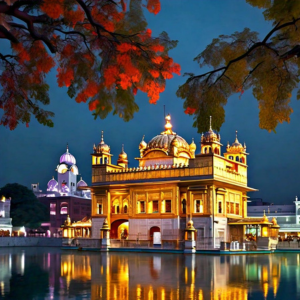Table of Contents
ToggleA Spiritual Journey to the Golden Temple : Unveiling the Abode of God

The Golden Temple, also known as Harmandir Sahib (meaning “The Abode of God”), is the spiritual heart of Sikhism, a religion founded in the 15th century in Punjab, India. This name signifies the temple’s role as a spiritual epicenter where divine presence is felt and revered. Its gleaming gold dome, reflecting on the holy waters of the Amrit Sarovar (Pool of Nectar), epitomizes the grandeur and serenity that beckons pilgrims and visitors from all corners of the globe. This blog delves into the rich tapestry of myths, legends, and spiritual tales surrounding this iconic pilgrimage site, offering a glimpse into its history, significance, and the message it reveals about religion in India.
A Timeless Legacy: Unveiling the History of the Golden Temple
The foundation of the Golden Temple is attributed to Guru Ram Das, the fourth Sikh Guru, in 1577. He envisioned a temple complex built on a platform in the center of a man-made lake, symbolizing the spiritual sanctuary accessible from all directions. Construction continued under the subsequent Gurus, with Guru Arjan Dev laying the cornerstone and overseeing the completion of the causeway leading to the temple.
The Golden Temple’s design is a blend of Islamic and Hindu architectural styles, symbolizing the unity of different faiths. The temple is built on a 67-foot square platform in the center of the Amrit Sarovar, a man-made pool of water. Its golden dome represents an inverted lotus flower, symbolizing purity and the Sikh devotees’ aim to live a pure life. The temple’s golden dome gives it an iconic appearance, reflecting the sun’s rays and symbolizing spiritual enlightenment. However, the temple’s sanctity goes beyond its opulent exterior. It houses the Guru Granth Sahib, the holy scripture of Sikhism, revered as the living Guru.
Myths, Legends, and Miracles: Unveiling the Spiritual Significance
The Golden Temple is steeped in myths and legends that add to its mystique. One popular tale narrates the miraculous intervention of Goddess Durga in selecting the site for the temple. Another legend speaks of a hidden doorway beneath the Amrit Sarovar, leading to a heavenly realm. The circumambulation (parikarma) around the pool is seen as a meditative practice, fostering inner peace and connection with the divine.
While the veracity of these stories remains in the realm of faith, they underscore the profound spiritual significance of the Golden Temple.
Amrit Sarovar healing properties
The ever-flowing water of the Amrit Sarovar is believed to possess healing properties, attracting devotees to bathe in its sacred waters. Pilgrims from all walks of life come to bathe in its waters, seeking physical and spiritual solace. Many miraculous healings have been reported by those who immersed themselves in the sarovar.
The Guru Granth Sahib Miracle
In the 18th century, during an attack on the temple by Mughal forces, the Sikh scriptures (Guru Granth Sahib) were placed on a small boat and set afloat in the Amrit Sarovar.
Miraculously, the scriptures floated back to their original place, saving them from destruction. This event underscores the deep faith and devotion of the Sikh community.
Perpetual Langar Service
The Golden Temple’s langar, or community kitchen, serves free meals to thousands of visitors daily. Run entirely by volunteers, the langar embodies Sikh principles of equality, service, and community.
A Beacon of Humanity: Unveiling the Sikh Principles
The Golden Temple’s design and practices embody the core principles of Sikhism. The four entrances to the complex represent the religion’s openness to all people, regardless of caste, creed, or gender. The langar, a community kitchen serving free vegetarian meals, exemplifies the Sikh concept of “seva” (selfless service) and equality. Here, everyone, from pilgrims to local residents, sits together on the floor, fostering a sense of community and humility.
The Golden Temple stands as a testament to the Sikh values of tolerance, social justice, and dedication to a higher purpose. Its message of universal brotherhood resonates with people of all faiths, making it a pilgrimage site not just for Sikhs but for anyone seeking spiritual solace and a deeper understanding of interfaith harmony.
A Journey for the Soul: Unveiling the Pilgrim’s Experience
A pilgrimage to the Golden Temple is a transformative experience. Here’s a glimpse into what awaits you:
- Preparation: Before entering the temple complex, pilgrims cover their heads and remove their shoes as a mark of respect. Headscarves are readily available for purchase nearby.
- The Parikarma: The circumambulation (parikarma) around the Amrit Sarovar is a calming and meditative experience. Take your time, absorb the serenity of the surroundings, and offer silent prayers.
- Darbar Sahib: The holiest part of the complex is the Darbar Sahib, the sanctum sanctorum housing the Guru Granth Sahib. Witness the continuous recitation (kirtan) of hymns by volunteer reciters (ragis).
- Langar Seva: Partake in the langar, a humbling experience of communal dining where everyone eats together. You can even volunteer for seva (service) in the kitchen, washing dishes or preparing food.
- Experience the Nightly Palki Sahib Ceremony: Witness the Guru Granth Sahib being carried in a palanquin to its resting place each night.
- Jalianwala Bagh: A short distance from the Golden Temple lies Jallianwala Bagh, a historical site commemorating a peaceful gathering that turned tragic under British rule. Pay your respects to the martyrs who lost their lives.
Unveiling the Golden Temple’s Message for Modern Times
In a world rife with social and religious divides, the Golden Temple offers a powerful message of unity and inclusivity. It reminds us of the importance of interfaith dialogue, serving others selflessly, and treating all people with respect. The serene atmosphere and spiritual practices inspire self-reflection and a renewed connection with the divine within.
Conclusion
The Golden Temple stands not only as a testament to Sikhism but also as a universal symbol of brotherhood, equality, and spiritual unity. Its stories, miracles, and unwavering devotion continue to inspire millions.
For more information, you can visit the official Golden Temple website.
FAQs
- What are the visiting hours of the Golden Temple?
The Golden Temple is open 24 hours a day, seven days a week, welcoming visitors at all times.
- Is there any dress code for visiting the Golden Temple?
Yes, visitors are required to cover their heads and dress modestly. Visitors must remove their shoes before entering the temple premises.
- Can non-Sikhs visit the Golden Temple?
Absolutely! The Golden Temple welcomes people of all faiths and backgrounds.
- Is photography allowed inside the Golden Temple?
Photography is allowed in the outer areas of the temple complex but is prohibited inside the main temple and during prayer services.
- What is the best time to visit the Golden Temple?
The temple can be visited year-round, but the best time is during the cooler months from October to March. Visiting during major festivals can also be a uniquely enriching experience.
Lorem ipsum dolor sit amet, consectetur adipiscing elit. Ut elit tellus, luctus nec ullamcorper mattis, pulvinar dapibus leo.
